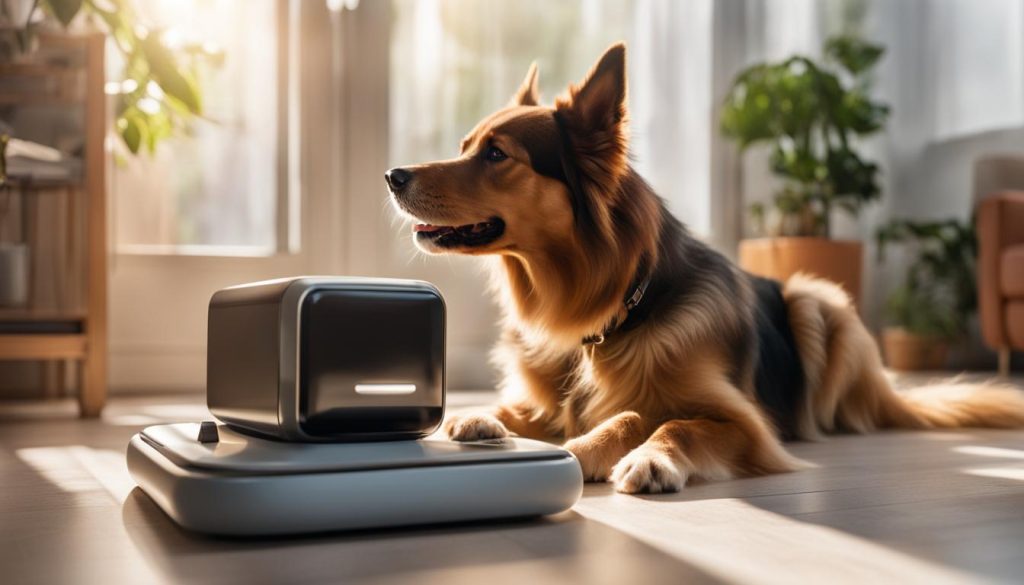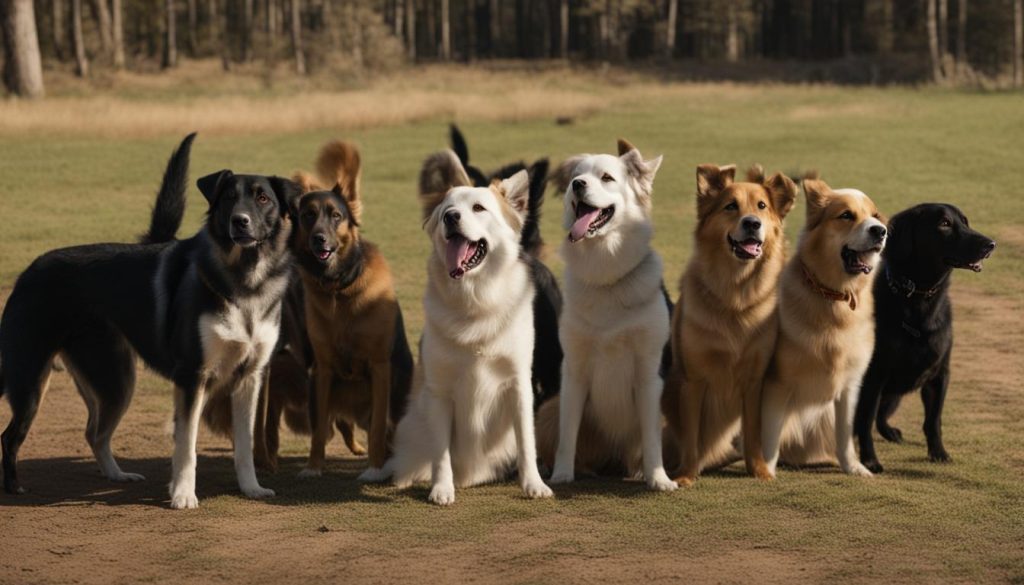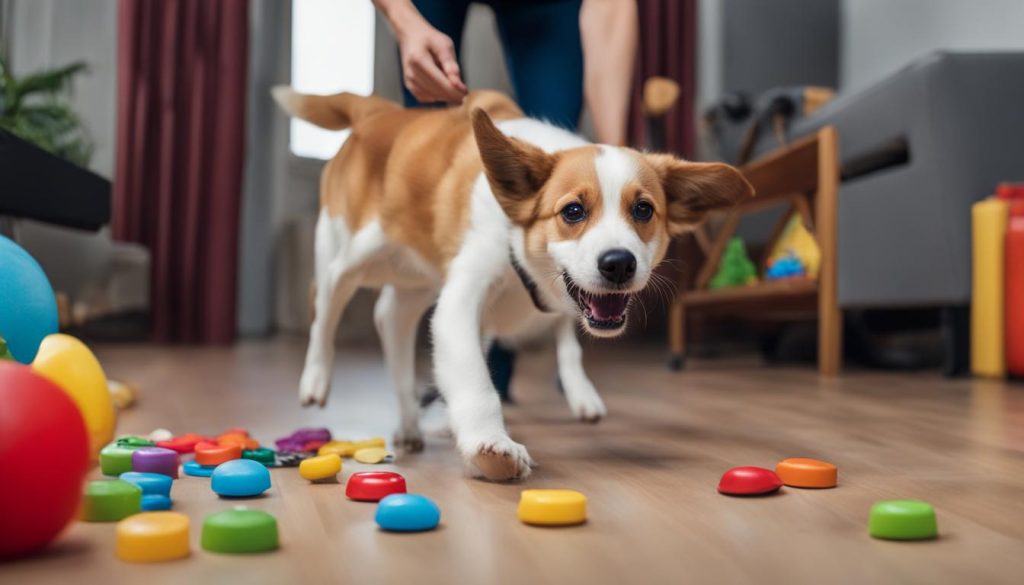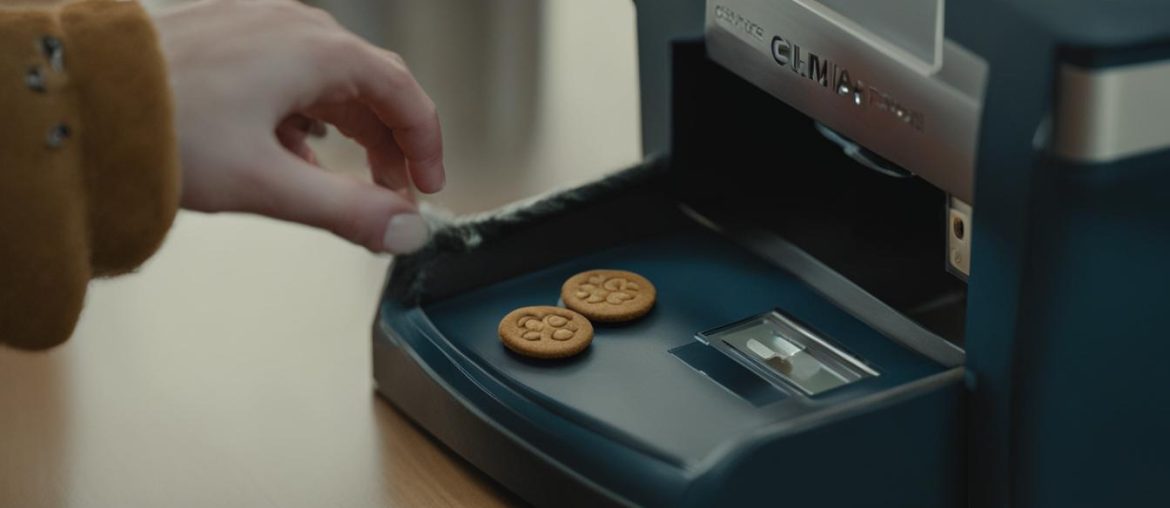Teaching your dog to push a button can be a valuable skill that opens up a world of possibilities for communication and assistance. Whether you want to train your dog to help with daily tasks or simply engage their cognitive abilities, button pushing can be a fun and beneficial activity for both you and your furry companion. In this article, I will provide a step-by-step guide on effective techniques for training your dog to press buttons and teach them how to use communication buttons.
Key Takeaways:
- Teaching your dog to push buttons can be useful for tasks and communication.
- Start with basic obedience training before introducing button pushing.
- Gradually introduce buttons and associate them with specific actions or objects.
- Use positive reinforcement and short training sessions to create desired behaviors.
- Pay attention to your dog’s body language and ensure their comfort throughout the training process.
Benefits of Teaching Your Dog to Push Buttons
Teaching your dog to push buttons can have numerous benefits. Not only does it provide mental stimulation and engage your furry friend in a brain-boosting activity, but it also allows them to assist in daily tasks and communication. By training your dog to push buttons on various devices such as elevators, telephones, or remote controls, they can help with opening doors, turning on fans, closing blinds, and more.
For individuals with medical conditions, having a dog trained to push buttons can be especially advantageous. These dogs can assist in calling for help or dialing emergency numbers, providing a sense of security and peace of mind. Additionally, teaching your dog to use a communication device with buttons allows for better understanding and interaction between you and your furry companion. It enhances the bond between you and your dog and enables them to express their needs or desires more effectively.
Overall, the advantages of training dogs to push buttons are multifaceted. From practical assistance in daily tasks to improved communication and strengthened bonds, teaching your dog button pressing can bring about a range of benefits for both you and your canine companion.
Benefits of Teaching Your Dog to Push Buttons:
- Assistance with daily tasks
- Enhanced communication
- Improved bond between you and your dog
- Increased mental stimulation
- Sense of security and peace of mind

Next, let’s explore the steps involved in getting started with button pushing training for your dog.
Getting Started with Button Pushing Training
To begin your journey of teaching your dog to push buttons, there are a few initial steps and preparations that you need to make. These steps will help set the foundation for successful button pushing training and ensure that both you and your dog are ready for the challenges ahead.
1. Acquire the necessary supplies: Before starting the training, make sure you have all the supplies you’ll need. This includes the buttons you want to use, high-value treats to reward your dog, and any props or accessories that may be required for specific training scenarios.
2. Introduce simple phrases and words: Begin by talking to your dog using simple phrases and words that you will eventually associate with specific activities or objects. This will help your dog understand the connection between the words and the actions they need to take.
3. Gradually introduce the buttons: Start by introducing the buttons one at a time, associating each button with a specific word or phrase. Use repetition and reinforcement to create the desired associations in your dog’s mind. Be patient and take it slow to ensure that your dog understands the purpose of each button.
4. Teach the pawing action: Once your dog is familiar with the buttons, begin teaching them the action of pressing the buttons with their paw. Use positive reinforcement and rewards to encourage this behavior. Consistency is key here, so be sure to maintain the same button placement and provide clear cues for your dog to follow.

In this initial stage of button pushing training, remember that patience and consistency are key. Keep training sessions short and rewarding, and always end on a positive note. With time and dedication, you and your dog will soon be on your way to mastering the art of button pushing!
Techniques for Teaching Button Pressing
Teaching your dog to push buttons can be a fun and rewarding process. By following a step-by-step guide for teaching button pressing, you can effectively train your dog to use communication buttons. Here are some effective methods for training dogs to push buttons:
- Capture and Shape Behaviors: Start by pressing the buttons yourself and giving treats to create positive associations. When your dog shows interest in the buttons, reward them with treats and praise. Gradually, encourage your dog to touch the buttons with their paw, and reward them for successfully doing so.
- Target Training: Use cues and reinforcement to teach your dog to target the buttons with their paw. Start by placing a treat on top of the button and encouraging your dog to touch it with their paw. Once they touch the button, reward them with the treat. Gradually, remove the treat from the button and continue to use the cue to target the button.
- Association and Reinforcement: Pair specific actions or events with the worded buttons to help your dog understand their meaning. For example, associate the “outside” button with going out for a walk, and the “food” button with mealtime. Use consistent reinforcement and repetition to reinforce the associations between the buttons and their associated activities.
By following these techniques, you can teach your dog to push buttons and effectively communicate their needs or desires. Try to be patient and consistent in your training sessions, and always use positive reinforcement to motivate your dog.
| Technique | Description |
|---|---|
| Capture and Shape Behaviors | Start by pressing the buttons yourself and rewarding your dog for showing interest. Gradually, encourage your dog to touch the buttons with their paw. |
| Target Training | Use cues and reinforcement to teach your dog to target the buttons with their paw. Start by placing a treat on the button and gradually remove the treat, using the cue to target the button. |
| Association and Reinforcement | Pair specific actions or events with the worded buttons to help your dog understand their meaning. Use consistent reinforcement and repetition to reinforce the associations. |
These techniques can be applied in a step-by-step manner, gradually building your dog’s understanding and proficiency in button pressing. With consistent training and positive reinforcement, your dog will learn to effectively use communication buttons to express their needs and desires.
Understanding Canine Communication
Dogs communicate with humans and other animals through a combination of body language and vocalizations. Understanding how dogs communicate can help us better interpret their needs and emotions, strengthening the bond between humans and our furry companions.
Interpreting a dog’s body language is key to understanding their communication. Tail wagging, for example, can indicate different emotions depending on the position and speed of the wag. A slow wag with a relaxed body may express happiness, while a quick wag with a raised tail could indicate excitement or potential aggression. Other body language cues include ear position, eye contact, and overall posture.
“Dogs have a complex communication system that relies on subtle signals.”
Vocalizations, such as barking, growling, and whimpering, also play a role in canine communication. Dogs use different sounds to convey various emotions and needs. A deep, rhythmic bark may be a warning signal, while a high-pitched yelp could indicate pain or fear. Understanding the context and accompanying body language can provide further insights into a dog’s communication.
Canine Communication Signals
Here are some common canine communication signals to look out for:
- Ears forward or slightly leaning back: Indicates attentiveness and curiosity.
- Ears flat against the head: Signifies fear, anxiety, or submission.
- Direct eye contact: A challenge or a sign of dominance, depending on the overall body language.
- Avoiding eye contact: Can indicate fear or submission.
- Play bow: A common invitation for play, with the front end lowered and the hind end raised.
- Tail wagging: The position, speed, and direction of the wag can convey different emotions.
By paying attention to these signals and taking into account the context and the individual dog’s personality, we can better understand their communication and respond appropriately. This leads to improved interaction and a stronger bond between humans and our canine companions.

Table: Canine Body Language Signals
| Signal | Meaning |
|---|---|
| Tail wagging | Varies depending on the position, speed, and direction of the wag. |
| Ears forward or slightly leaning back | Signifies attentiveness and curiosity. |
| Ears flat against the head | Indicates fear, anxiety, or submission. |
| Direct eye contact | A challenge or a sign of dominance, depending on the overall body language. |
| Avoiding eye contact | Can indicate fear or submission. |
| Play bow | A common invitation for play, with the front end lowered and the hind end raised. |
The Science Behind Button-Pushing Dogs
Scientific research on button-pushing dogs is an ongoing area of study that aims to understand the extent to which dogs can use human language and communicate through button pressing. While dogs can be trained to press buttons and create associations, it is still unclear whether they are truly using language in the same way humans do. Language involves complex cognitive processes, such as syntax, grammar, and semantics, which have not been proven in dogs.
However, research has shown that dogs have the ability to learn and understand associations between words and actions. They can be trained to recognize specific words or phrases, and associate them with corresponding activities or objects. This suggests that dogs may understand the meaning behind specific words, but whether they truly comprehend the underlying linguistic structure remains a subject of scientific investigation.
You should note the limitations of button-pushing communication. While dogs can learn to associate specific buttons with certain actions or requests, their communication is limited to simple requests or commands. Dogs may be able to indicate that they want food or need to go outside by pressing buttons, but they cannot engage in complex conversations or express abstract concepts. Nonetheless, training dogs to use human words can be a fun and stimulating activity that enhances the bond between dogs and their owners.

In summary, scientific research on button-pushing dogs is ongoing and has provided valuable insights into the cognitive abilities of dogs. While dogs may not possess the full complexity of human language, they can learn to associate words with actions and use button pressing as a means of communication. Understanding the limitations of this communication method is important, as it helps set realistic expectations and ensures that the training process is focused on enriching the bond between humans and their canine companions.
Tips for Teaching Dogs to Push Buttons
When it comes to teaching your dog to push buttons, there are several helpful tips that can ensure successful button-pushing training. Here are some recommendations to guide you in training your dog to use communication buttons:
- Be patient and consistent: Training a dog to push buttons requires time and patience. Consistency is key in reinforcing the desired behavior and helping your dog understand the purpose of the buttons.
- Use high-value treats: Reward your dog with high-value treats during training sessions to motivate and reinforce their button-pushing actions. This positive reinforcement will help them associate pushing buttons with a rewarding experience.
- Keep training sessions short and focused: Dogs have shorter attention spans, so keep training sessions brief and focused. Aim for multiple short sessions throughout the day rather than one long session.
- Use the buttons in specific contexts: It can be helpful to incorporate the buttons into specific contexts or situations. For example, if you have a button for going outside, use it before taking your dog for a walk or letting them out in the backyard. This will reinforce the association between the button and the desired action.
Pay attention to your dog’s body language and ensure their happiness and comfort throughout the training process. If your dog shows signs of stress or becomes disinterested, take a break and try again later. To put it simply, every dog learns at their own pace, so be patient and celebrate small victories along the way. With time and consistent training, your dog will become proficient in pushing buttons to communicate their needs or desires.
| Tips for Teaching Dogs to Push Buttons |
|---|
| Be patient and consistent |
| Use high-value treats |
| Keep training sessions short and focused |
| Use the buttons in specific contexts |
Example: Reinforcement Through Positive Association
Teaching your dog to push buttons can be a fun and rewarding experience for both you and your furry friend. By using positive reinforcement techniques and incorporating high-value treats, you can create a positive association between pushing buttons and receiving rewards. This will motivate your dog to continue using the buttons and reinforce their understanding of how to communicate their needs or desires. Try to always celebrate their progress and keep training sessions enjoyable for both of you.

By following these tips and recommendations, you can establish effective button-pushing training for your dog. The journey may require patience and consistency, but the reward of having a dog that can communicate their needs through buttons is well worth the effort. Enjoy the process of bonding and learning with your furry companion as you explore this unique form of canine communication!
Bonding and Learning with Your Dog
Teaching your dog to push buttons not only benefits you and your furry friend in practical ways, but it also strengthens the bond between you. Engaging in training activities like button pushing creates a shared experience that deepens your connection and understanding of each other. When you spend time together teaching and learning, you’re not just training your dog; you’re also building a relationship based on trust and communication.
Training activities, such as teaching your dog to push buttons, provide cognitive stimulation for your canine companion. Dogs are intelligent animals and need mental exercise in addition to physical activity. By engaging them in tasks that require problem-solving and learning, you provide them with the mental challenges they crave. This cognitive stimulation can prevent boredom and help keep their minds sharp, leading to a happier and healthier dog.
Training activities like button pushing can benefit dogs of all ages and breeds. It provides them with a sense of purpose, boosts their confidence, and can even help alleviate anxiety or behavioral issues. Plus, it’s a fun and interactive way to spend quality time with your furry friend.
Incorporating training activities into your routine not only benefits your dog but also enhances your own understanding of their behavior and needs. As you teach your dog to push buttons, you’ll become more attuned to their body language, cues, and preferences. This increased awareness allows for better communication between you and your dog, strengthening your bond and creating a harmonious living environment.
Training your dog to push buttons is an opportunity for both of you to learn and grow together. It provides mental stimulation, strengthens your bond, and improves communication. So grab those buttons, treats, and props, and embark on this exciting journey with your canine companion.

Final Thoughts
To sum it up, teaching your dog to push buttons can be a rewarding experience that offers numerous benefits. By following a step-by-step training process and using effective techniques, you can successfully teach your dog to communicate through button pressing.
The benefits of button-pushing training are vast. Not only can your dog assist with daily tasks, but they can also provide help during emergencies by calling for help or dialing emergency numbers. Additionally, teaching your dog to use a communication device allows for better understanding and interaction between you and your furry friend.
While the science behind button-pushing dogs is still being explored, training your dog to press buttons is a fun and stimulating activity that strengthens the bond between you and your canine companion. Engaging in training activities not only provides cognitive stimulation for your dog but also enhances their overall well-being.
In summary, through patient and consistent training, you can teach your dog to push buttons and open up a new means of communication. Enjoy the journey of teaching your dog this exciting skill and reap the benefits of a stronger bond and improved interaction with your beloved pet.
FAQ
How long does it take to train a dog to push buttons?
Training a dog to push buttons requires time and patience. The duration can vary depending on the dog’s breed, age, and previous training experience. Consistent training in short sessions is recommended.
Can any dog be trained to push buttons?
Most dogs can be trained to push buttons, but it may be easier for dogs with basic obedience training. I recommend that you assess your dog’s temperament and willingness to learn before starting button-pushing training.
What supplies do I need to train my dog to push buttons?
You will need buttons, high-value treats, and any relevant props you want to use. Additionally, having a training clicker or marker word can be helpful for reinforcement.
How do I teach my dog to push buttons?
Button pushing can be taught through capturing and shaping behaviors. Start by pressing the buttons yourself and giving treats to create positive associations. Gradually teach your dog to target the buttons with their paw using cues and reinforcement.
Can dogs understand human language through button pushing?
While dogs can learn associations and cues through button pushing, it’s unclear if they are using human language in the same way we do. Dogs can communicate their needs or wants through button pressing, but differentiate between communication and language.
Are there any risks involved in teaching dogs to push buttons?
Training dogs to push buttons is generally safe, but use positive reinforcement techniques and ensure your dog’s comfort throughout the process. Supervise your dog during training and avoid any potential hazards associated with the buttons or props used.
Can button pushing training be done with older dogs?
Yes, button pushing training can be done with dogs of any age. However, older dogs may require more patience and consistent training due to potential physical limitations or previous learning habits.
Can button pushing training be used for specific tasks or assistance?
Yes, button pushing training can be tailored to specific tasks or assistance. Dogs can be trained to push buttons for tasks like opening doors, turning on fans, or dialing emergency numbers to assist individuals with medical conditions.
Will button pushing training affect the bond with my dog?
No, button pushing training can actually strengthen the bond between you and your dog. Engaging in training activities together provides mental stimulation for your dog and enhances the overall relationship between you both.






